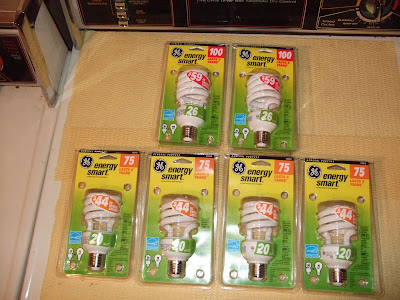CFLs for a Buck!
I don't have a filter for "locals," so apologies to my far-flung reader for the irrelevance. However, there's other electrical geekery below that.

I stopped by Tag's in Porter Square last night on the way home, and went by the light bulb section. They are selling CFLs for 99 cents each! I talked to the clerk--they're basically trying to clear out inventory (they got a huge bunch of them). I believe he said the supplier overcharged them recently, so they made up the difference in CFLs, and Tag's is now trying to clear out that inventory.
They are in a cloth bin directly opposite the display of CFLs in the basement. I believe they ran out of 100 W equivalent, but they had a fair number of 75 and 65 W equivalent. Limit was 6 per customer--I think I might try picking up another batch tomorrow morning.
UPDATE: I did stop by Thursday morning to pick up some more bulbs--they must have a good stock of them in back, because all of the bins were refilled.
EDIT: incidentally, as far as I can tell, these are not el-cheapo CFLs--they are name brand GE Energy Smarts. Froogle thinks they go for $5-$14 a piece, which is what made me say, "Wow!" about the clearance price. The price on the shelf is $5-$8. Also, their Color Rendering Index (CRI) is 82 (a good number)--explanation for previous blogging here.
I installed a bunch in the basement--they make it really bright down there now. The spectrum seems fine, if you're ok with CFLs (i.e., I have had the 'daylight bulb my ass' problem with some bulbs in Canada).
Also, speaking of energy geekery, the kitchen table here is now the command center:

Items include:
- An indoor-outdoor temperature reader (pretty important if you bike to work)
- A temperature-relative humidity sensor connected to a datalogger I have in the basement. It collects T/RH data in five spots in the house (including the basement), outdoors, and monitors running of the heating and hot water systems
- A TED (The Energy Detective)--one of the electrical power meters that I blogged about previously. We had a few spares around work, so I borrowed one. It's actually kinda entertaining--you can watch as things turn on and off around the house ("Yep, there's the fridge... and the washing machine is going into spin cycle... and now it's off..."). Actually, JMD and I have been sitting around watching the thing... it gets a bit mesmerizing after a while (it has this green blinking LED).


4 Comments:
That was going to be my line, too...
Dude, c'mon, that sort of geekery is something to be proud of, not ashamed. The only problem with it is that it keeps you at home staring at blinking lights instead of out meeting women who would think it's cool (and, no, I don't know where those women would be offhand, but they've got to be out there).
*I* think it's cool!
But that doesn't really help.
I'm thinking about building a vertical axis wind turbine at my parents' house while I'm there for two weeks around xmas. I was looking at getting my dad a wunderground weather station for xmas, but the cheapest at $200 had a anemometer that had an accuracy of +/- 10%, which doesn't seem good enough. I guess wind speed is one of the environmental measurements you aren't really focused on?
*I* think it's cool!
Oooh... [rawr] ;)
I'm thinking about building a vertical axis wind turbine at my parents' house while I'm there for two weeks around xmas.
Hey, that sounds like a totally cool project. However, note the previous caveats about vertical axis wind turbines from a presentation that I went to. However, it does seem more realistic to assemble a VAWT on a smaller scale.
I was looking at getting my dad a wunderground weather station for xmas, but the cheapest at $200 had a anemometer that had an accuracy of +/- 10%, which doesn't seem good enough.
Yeah, I don't know of a cheap decent anemometer. Some of my colleagues use the Davis Instruments Anemometer ($120, +/- 5%); however, it is just the raw instrument--you need a datalogger that can measure voltage and pulse counts to do anything with it.
I guess wind speed is one of the environmental measurements you aren't really focused on?
We actually measure wind in a lot of our work (as per the above)--it is useful in our research on moisture performance and durability of building assemblies. Specifically, you can take rain data, and wind direction/speed, and figure out how much driving rain (i.e., sideways blown rain) is hitting a wall, which is a big loading factor for moisture in walls. Also, I suppose you can calculate how much air infiltration is being driven by wind, but I've never bothered running through the numbers.
I don't actively collect wind data here at home, but I actually have some slick tricks to collect wind and precipitation data. Weatherunderground.com has data in comma delimited files that you can download and use. I have a database covering wind and precipitation data, to go with my home logging geekery.
Post a Comment
<< Home